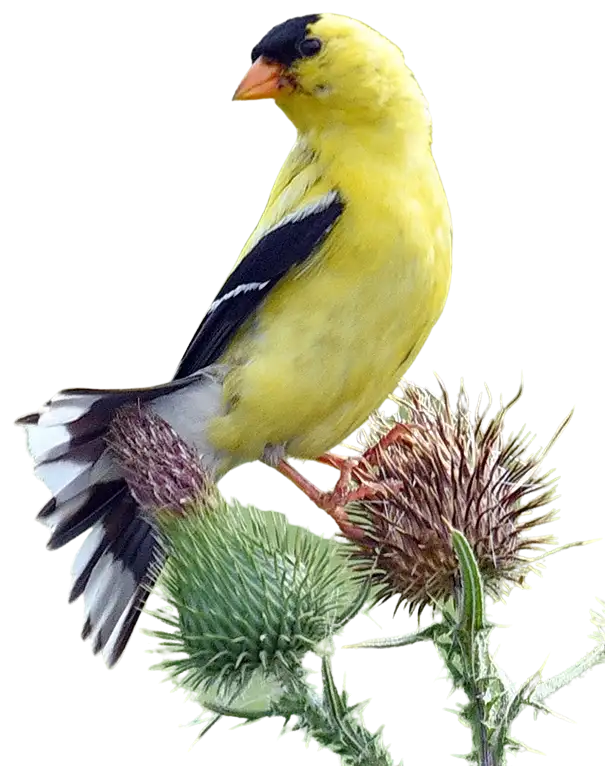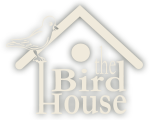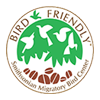Bird Friendly Gardening
Watching a Black-capped Chickadee peck open a seed on the branch of a droopy pine tree, listening to a Northern Cardinal sing from the shelter of a hedge, or finding a Carolina Wren nesting in a planter on your porch are delightful moments many birders have from home. While not every bird will frequent every backyard, there are many things you can do to make your local patch more attractive to nesting, migrating, and wintering birds no matter if you have 160 acres or a postage-stamp balcony.
1. Select plants that are native to Western NY
Not only are native plants beautiful, they are often more low-maintenance than their imported counterparts as they are already well-adapted to the environmental conditions of our area. That alone might be reason enough to prefer them, but they also carry an enormous value for our local wildlife communities. Did you know:
- Native plants support more insects than do non-natives, as the species that have been introduced were often chosen to be resistant to the local insect fauna. In fact, research shows that non-native plants provide 68% less food for insects, than do native plants. While we might not relish the thought of hundreds of caterpillar larva on our trees, more insects mean more birds!
- The fruits of many native plants have a higher nutitional value than their non-native counterparts.
- Native plants have the nesting sites and materials our local birds are accustomed to.
- Native plants can attract species that don’t normally visit feeders, like warblers and tanagers.
For online resources or local nurseries specializing in native plants, scroll to the links at the bottom of the page.
2. Think in Three Dimensions.
Native habitats have a three-dimensional structure. For example, forests have a high canopy of tall trees, an intermediate story of shorter trees and upright bushes, an understory of shrubs and other forbs, a ground cover of moss and creeping ivy, and a layer of leaf litter – all of which are connected with vines and trailing plants. As much as possible, try to mimic a natural structure by incorporating plants of different heights into your garden habitat, and arrange several plants of a single species in a cluster.
3. Pay Attention to Different Food Groups.
Choose plants that offer a variety of food sources. Native plants encourage a variety of invertebrates like worms, insects, and spiders. These high-protein foods are vital (even for hummingbirds!), especially during the breeding season. Nuts and seeds are another crucial source of protein and fat; both trees and flowers can be excellent sources of these tasty treats. Early-ripening fruits like mulberry and cherry, later-ripening fruits like dogwood and viburnum, and winter-persisting fruits like crabapple and sumac all provide a welcome boost of energy and nutrition. Flowering plants can be a source of nectar for hummingbirds, and they may also attract insect pollinators.
4. Embrace Weeds and Bugs
Perfectly manicured and weedless lawns are nice for an afternoon game of badminton, but they are terrible for birds. Spraying herbicides and pesticides on a lawn not only eradicates a valuable food source, it has the risk of directly or indirectly poisoning birds.
5. Create Shelter
A brush pile can turn an unused corner of your yard into fantastic spot for birds to hang out, well-protected from weather and predators. Lashing discarded Christmas trees to fence posts is another way to provide extra shelter during the winter months. If it is safe to do so, consider leaving dead snags standing to provide habitat for cavity nesters like chickadees and woodpeckers. If you would like to hang a nest box, avoid paint or stain that is not bird-safe and eliminate any perches below the entrance. Choose boxes with sloping roofs to shed rain, drainage holes, an access door for cleaning, and an appropriately-sized entrance hole. Be a responsible landlord – clean the box annually and be sure to eject House Sparrows and other non-native birds that may outcompete our native bluebirds and swallows.
6. Don’t Forget the Water
Whether it’s for bathing or for drinking, you may find that a water source is even more effective than feeders at drawing birds to your yard. Birdbaths come in a variety of styles and materials; boulders with shallow divots and even old cookie sheets work just as well. Birds enjoy shallow puddles and pools no more than 3″ deep, and a bit of moving water or a continuous drip may be especially inviting. Be sure to keep your water feature clean by scrubbing it regularly with a stiff brush.
7. Making it Work in a Small Space.
No backyard? No problem! You can still attract birds through the creative use of container gardening on window ledges, stoops, balconies, and rooftops. Planting community gardens is another great way to attract birds to an urban landscape.
8. Check Out These Great Resources!
General Resources
Finger Lakes Native Plant Society
Ithaca Native Landscape Symposium, conference held annually in March
Plants for Birds, National Audubon Society
Urban Gardening for Birds, Cornell Lab of Ornithology
Lists of Plants Native to New York
Landscaping with NYS Native Plants, Town of Brighton
Native Flowers for Gardening and Landscaping, DEC
Native Plant Database, National Audubon Society
Native Plants in the NY Finger Lakes, Finger Lakes Native Plant Society
Recommended Plantings for New York, Lady Bird Johnson Wildflower Center
Nurseries Specializing in Native Plants
Amanda’s Garden, Dansville
Plantsmen Nursery, Groton
White Oak Nursery, Canandaigua
Annual Plant Sales
DEC Spring Seedling Sale, open annually from January to early May
Genesee Land Trust, annually in spring



